
All images © by Roberto Piperno, owner of the domain. Write to romapip@quipo.it.
Notes:
Page revised in September 2021.

All images © by Roberto Piperno, owner of the domain. Write to romapip@quipo.it.
Notes:
Page revised in September 2021.
 Lambaesis (Lambese) and the Medrassen
Lambaesis (Lambese) and the MedrassenYou may wish to see an introductory page to this section first.
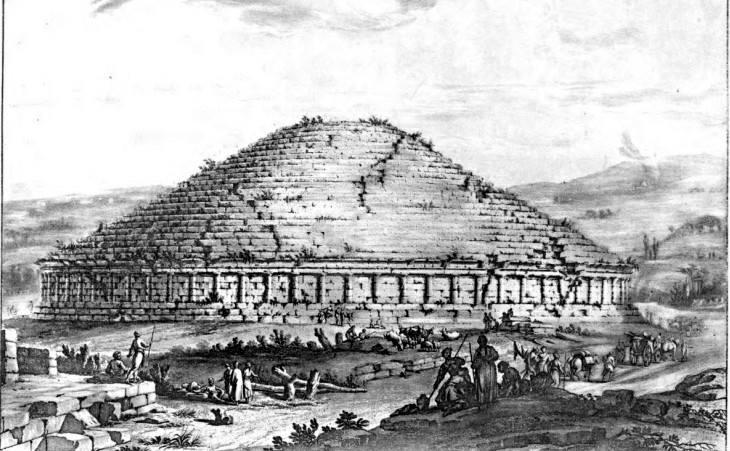
The Medrassen, a Numidian royal mausoleum, in a 1765 ink drawing by Robert Bruce and Luigi Balugani
Medrassem. Five Leagues to the E. of Tagouzainah, we have a very remarkable sepulchral
Monument, situated betwixt two Eminences. It goes by the
Name of Medrassem, or Mail Cashem, (The Treasure of Cashem)
being nearly of the same Fashion with That of the Kubber
Romeah, but different in being larger, and in having the
Cornice of the Base supported with Tuscan-like Pilasters. The
Arabs imagine, as They do with Regard to other large Piles, that
an immense Treasure lyeth buried beneath It; and have therefore made the like Attempts, as at Kubber Romeah to lay
It open.
Thomas Shaw - Travels, or, observations relating to several parts of Barbary and the Levant - 1738
The form is that of a
truncated cone, placed on a cylindrical
base. The lower portion,
which forms a vertical encircling zone
or ring, is ornamented by 60 engaged
columns, of which not one half are now
perfect. The upper part, or roof,
gradually diminishes, by a series of
steps. The columns are stunted,
much broader at the base than at the
top, the height being about four times
the lower diameter. They rest on three
steps, which serve as base both to the
monument and to the columns. The
capitals are Doric. (..) The exterior
masonry is remarkably fine, the stones
being of great size, well cut, the joints
not more in some places than the
thickness of a knife, and each stone
joined to its neighbour by a massive
clamp, probably of lead, the search
for which has greatly contributed to
the destruction of the building. Unfortunately the interior masonry was of
a much inferior kind, and an extensive
subsidence of it has caused a dislocation of the outer coating.
Travels in the footsteps of Bruce in Algeria and Tunis, illustrated by facsimiles of his original drawings by R. L. Playfair - 1877
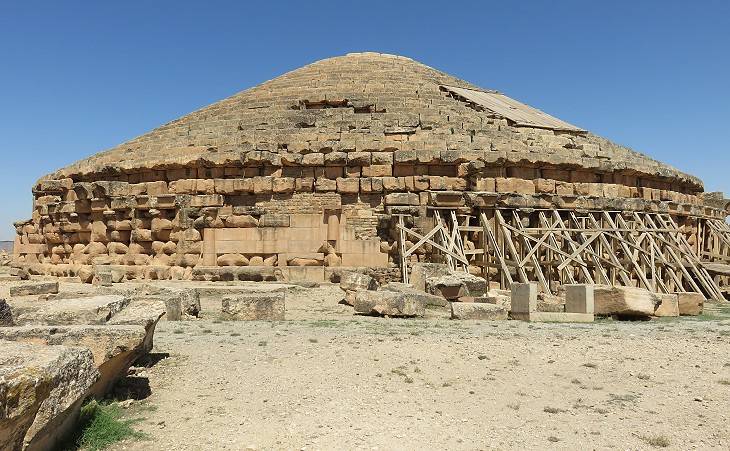
The Medrassen today
Various attempts have been made to penetrate it, but till quite recently without success. Salah Bey endeavoured to force an entrance by means of artillery. General Carbuccia commenced to explore it in 1849, and discovered the passage leading to the sepulchral chamber; but, owing to the roof having fallen in, he was unable to penetrate further. Commandant Foy resumed its exploration with no better success; Monsieur le Garde du Genie Bauchetet failed likewise in 1866; but being again sent in 1873, with more ample means, he succeeded in clearing away the debris and penetrating to the central chamber, which he ascertained to be 10 feet 3 inches long by 4 feet 7 inches broad. Nothing of any interest was found inside, but clear evidence was obtained that it had been opened at some former period, and that an attempt had been made to destroy the building by means of fire; great quantities of charcoal and lime (the latter the calcined stone of which it is built) were discovered, and the fire having communicated to the woodwork which supported the roof of the passage, the superincumbent masonry had fallen in and obstructed the entrance. Playfair 1877
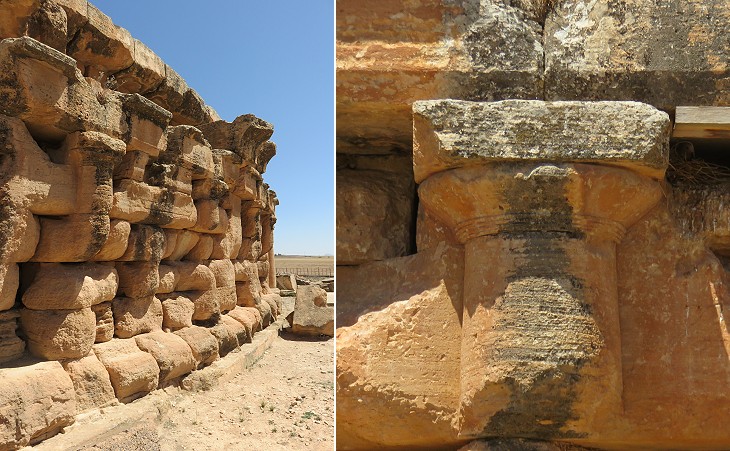
Architectural details; the image used as background for this page shows some graffiti which were carved on the mausoleum walls by XIXth century travellers
There has always been a general agreement that this building was older than Kubber Romeah, a similar mausoleum near Tipasa in Mauretania, but not on the person who ordered its construction. It is not the mausoleum of Massinissa, the Numidian king who greatly enlarged his possessions during the Second Punic War, because he was buried near Cirta/Constantina. Radiocarbon dating tests taken from cedar logs found inside the mausoleum indicate it was made by a predecessor of Massinissa. Its location in a rather remote area was perhaps meant to be a territory marker. It was surrounded by bazinas, small circular tombs.
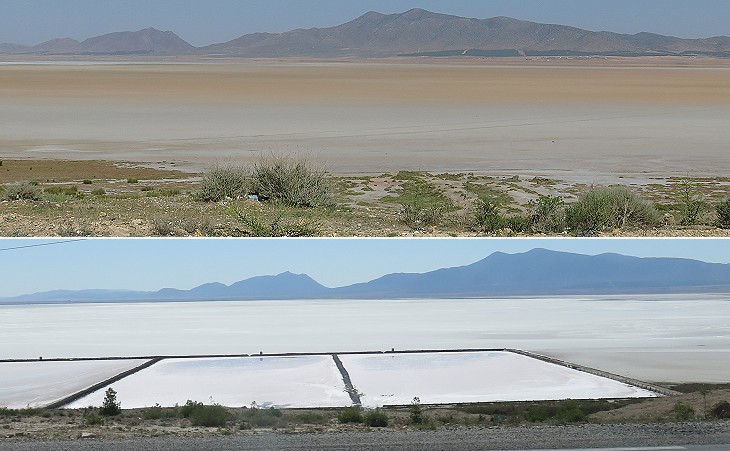
Sebkret ez Zemoul, a salt lake near the Medrassen and facilities for collecting its mineral contents
Les Chotts. These are two
large salt lakes, or rather marshes,
called Tinsilt and Mzouri, partly
covered with long grass, and the haunt
of innumerable wild fowl of all kinds.
(..) The salt from the marshes is collected
by a few Europeans, who live close by.
John Murray - Handbook for Travellers in Algeria and Tunis - 1895 (written by R. L. Playfair)
A sebkha is a smooth flat plain usually high in salt that may become a marsh or a shallow lake after a rain until the water evaporates. Similar salt lakes aka chott can be seen also in Southern Tunisia and on the Anatolian tableland, e.g. Lake Acigol. Tiny salt lakes can still be seen in Libyan Sahara.
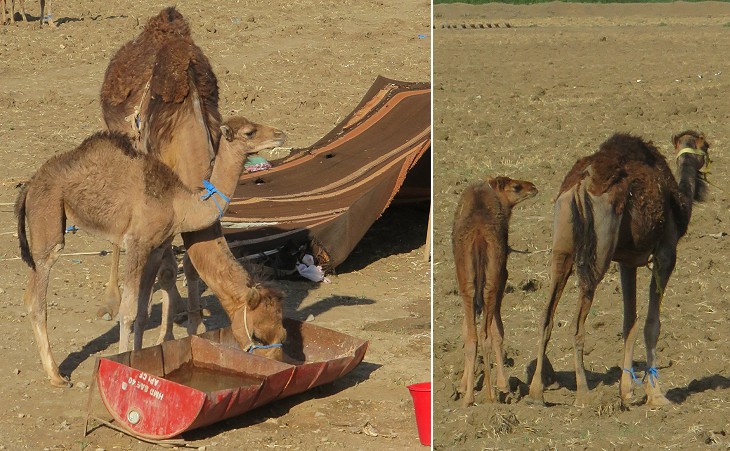
Dromedaries near Sebkret ez Zemoul
This dreary country is the home of several tribes of Arabs, whose herds, of sheep, goats and camels, may be seen all around. Murray 1895

(above-left) Arch of Emperor Septimius Severus; (above-right) Arch of Emperor Commodus (seen from the bus); (below) amphitheatre (seen from a great distance)
Tezzoute (today's Tazoult), three Leagues nearly in Circumference. We have
here a great Variety of Antiquities; for besides the magnificent
Remains of several of the City Gates (which according to a
Tradition of the Arabs, were forty in all), and that when the
Place was in Prosperity, It could send out of each Gate forty
thousand armed men, we have the Seats and upper Part of
an Amphitheatre; the Frontispiece of a beautiful Ionick Temple,
dedicated to Esculapius; a large oblong Chamber, with a great
Gate on each Side, intended perhaps for a triumphal Arch. Shaw
The remains of the Amphitheatre are
outside the walls, below the town and
camp. It is in a very bad state of
preservation, but some of the steps are
still entire. Murray 1895
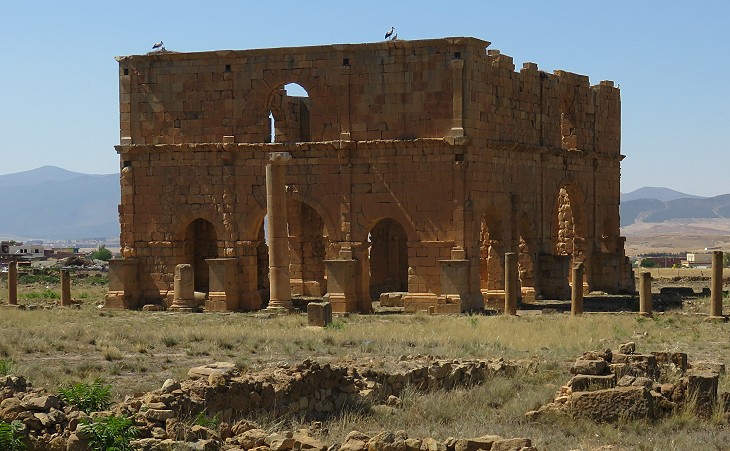
View of the archaeological site
Travellers of the past had the opportunity to see the ruins of Lambaesis in a much better state than they are today. James Bruce left some notes about his visit in 1765: Here must be fixed "Lambaesitanorum Colonia", which, by a hundred Latin inscriptions remaining on the spot, it is attested to have been. It is now called Tezzout; the ruins of the city are very extensive. There are seven of the gates still standing, and great pieces of the walls solidly built with square masonry without lime.
R. L. Playfair described it in 1877: It was one of the most important cities in the interior of Numidia, and was in Roman times the headquarters of the Third Legion, Augusta, which was stationed here for nearly three centuries, and was the only one located in Africa. It was the great military centre from which columns were despatched to maintain order or to suppress insurrection. It covered, or protected, the whole of Northern Numidia, and permitted Roman colonisation to attain a degree of importance unequalled in any other province of North Africa. At present very few ruins remain to bear witness to its former magnificence, and (..) indeed, it is impossible to avoid the conclusion that, valuable as the place undoubtedly was as a military position, the importance of its public buildings has been greatly exaggerated. The principal ruin here, and the only one figured by Bruce, is that called the Praetorium. In 1895 he added in Murray's Handbook: Lambessa consists of a small modern village close to
the Roman ruins. The principal building is the prison. This was formerly
used for political offenders, and contained many gentlemen of good position,
whose only offence was being obnoxious
to the French empire (some monuments were included in the wall of the prison and are no longer visible). (..) The walls (of the ancient town) have been destroyed by the
French, to build the neighbouring farm-houses, and their very direction and
extent can hardly now be ascertained.
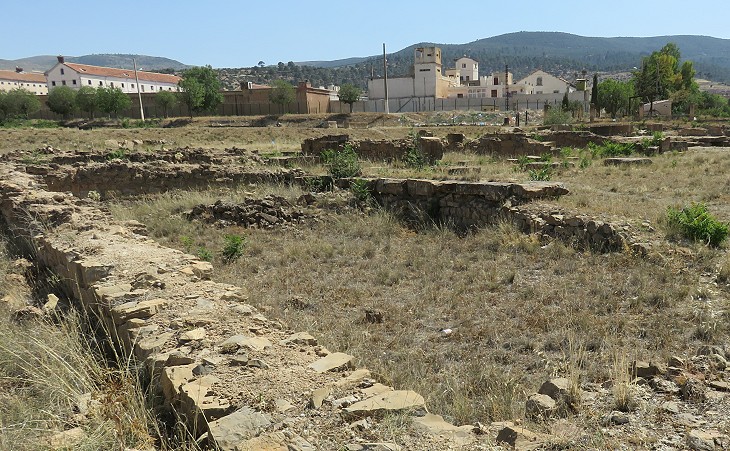
Site of a small forum and the modern town with the prison in the background
Today a visit to the ruins of the ancient town is a worrying experience because the site is unattended and the museum is closed although a catalogue published in 1895 already indicated that it was extremely rich in statues, mosaics and inscriptions. In January 2016 Le Matin d'Algérie reported that Quant au musée, une vieille bâtisse coloniale qui a réussi à préserver une précieuse collection, il risque de s'écrouler d'un jour à l'autre sur ses oeuvres (the museum, a small building of the colonial period which managed to retain a precious collection, is at risk of collapsing from one day to another upon its exhibits).
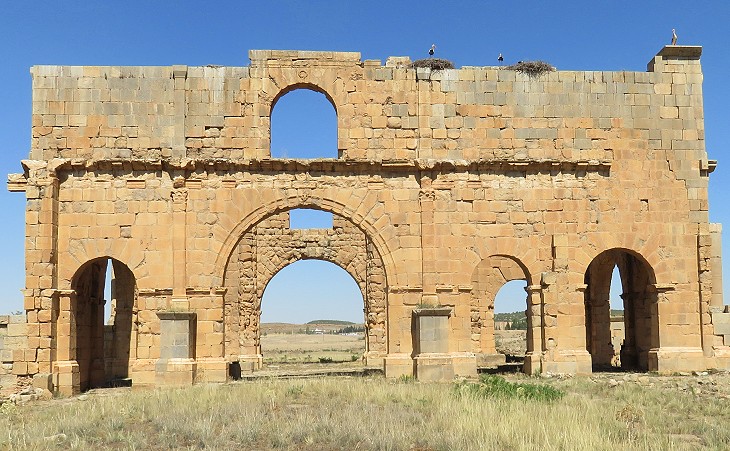
"Principia", the headquarters of a Roman military camp or fortress
It is a large rectangular edifice, 92
feet long, 66 broad, and 49 high. The
principal side, to the south, had a
splendid peristyle, having massive Ionic
columns in front, which corresponded
with Corinthian pilasters engaged in
the walls. This extended only to half
the height of the wall, leaving a second
storey externally, but there is no trace
of this in the inside, which is undivided
in height. The other sides also are decorated with detached columns, corresponding to the pilasters of the lower
storey, the cornice turning round and
forming the entablature. On the north
side there are three detached columns
on each side of the principal entrance,
between which and the smaller doors is
a niche to contain statuary. The interior forms a vast hall; on each side there is one large
and two smaller doors, and above the
central and larger ones another arched
opening, used probably as a window. (..) The interior has now been converted
into a museum, wherein are collected
various objects of antiquity which have
been discovered in the vicinity; the
best of these, however, have been sent
to the museum of the Louvre at Paris. Playfair 1877
The building became part of the local headquarters of the French Army and during ceremonies troops marched through it. Some of the works of art sent to Paris were eventually returned to the Archaeological Museum of Algiers; they included a fine bronze statue of a boy with an eagle.
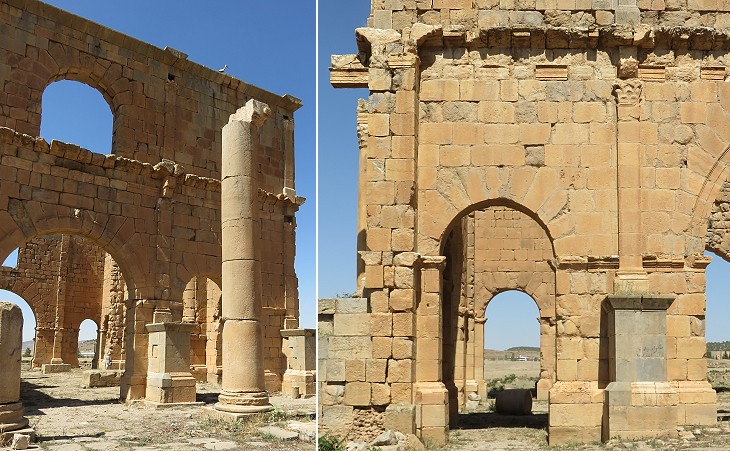
"Principia": (left) side towards the forum; (right) details of the western side
What its use was I know not. It was certainly designed for some military purpose, by the size of its gates, I should suspect, a stable for elephants, or a repository for catapults, or other large military machines, though there are no traces left upon the walls indicating either. From Bruce's 1765 notes
Archaeologists are now positive in indicating that the building housed the headquarters of Legio III Augusta. In 100 AD Emperor Trajan relocated the legion to Lambaesis from Theveste, a town closer to today's border with Tunisia, not far from Sufetula. At the same time Trajan founded Thamugadi, a town between Lambaesis and Theveste where veterans of Legio Ulpia Victrix were settled, thus strengthening the Roman control on areas which were at risk of being raided by nomadic tribes living in the Sahara desert, similar to the Libyan Garamantes. You may wish to see Roman military towns in Britain, Germany and Austria.
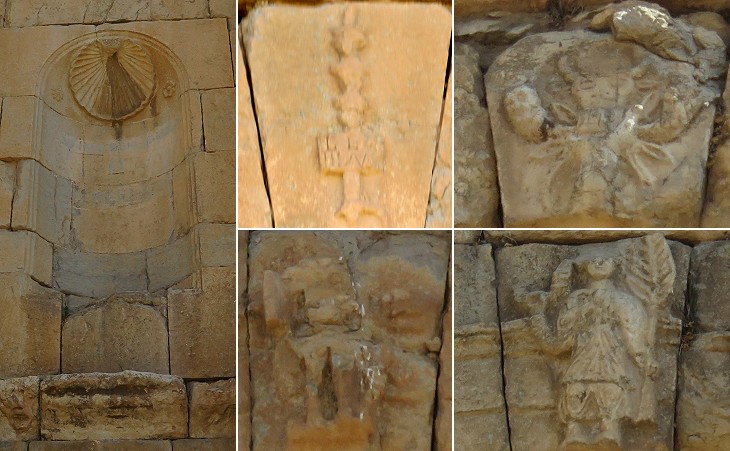
Details: (left) a decorated niche; (centre/right) reliefs on the keystones, one of which shows a standard with the inscription LEG III AUG
In 128 Emperor Hadrian visited Lambaesis where he delivered an adlocutio, an address to the troops after having watched their exercitatio (military exercise). The commander of the legion had it carved in a long inscription which provides interesting information about the organisation and training of a Roman legion. In his long speech the Emperor praised the military engineering skills of the troops, a key element of the strength of the Roman army: The regiment has accomplished in one day things that normally require several days; it completed a very extensive field fortification, of the type normally used for winter base camps, in a period of time that was not much longer than what is needed when strips of turf are used, which, cut into equal sections according to their type, can easily be obtained and handled, whereas in this case large, heavy stones and rocks were used, which can neither be transported, nor lifted, nor built up without matching up the unevenness between them. The ditch, which the regiment had to lay out in hard rocky ground, was correctly dug, and the sides were smoothed off by hewing. After the completion of this work, the camp was occupied, a meal was quickly cooked, and the troops again formed up.
Modern translation by Walter J. Renfroe Jr in The Barbarian Invasions by Hans Delbruck - 1980
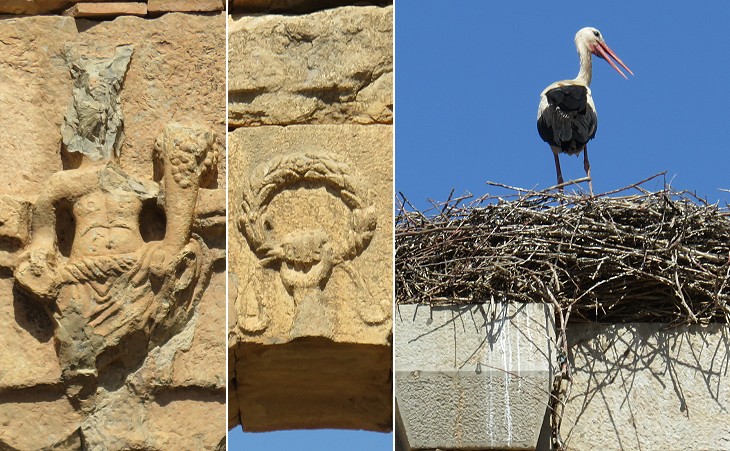
Details: (left/centre) other reliefs on the keystones; (right) a temporary tenant
Hadrian knew what he was talking about and while praising the troops, he had some reservations on the commanders: His excellency, General Catullinus, had planned the manoeuvre (general concept) in such a way that the combat situation corresponded closely to a wartime situation; this point I must commend. The execution by the troops also deserves high praise. Colonel Cornelianus showed himself equal to the demands of his position. I cannot approve his attacks in an extended line. The regulations of Emperor Augustus prescribe that the cavalry not advance carelessly out of its cover and that it pursue cautiously: if the rider cannot see where he is going or cannot bring his horse to a halt whenever he wants to, he will plunge into pitfalls. The attack must be in closed formation.
This treatise on the Roman army complements that which is illustrated in marble by the reliefs of Colonna Traiana in Rome.
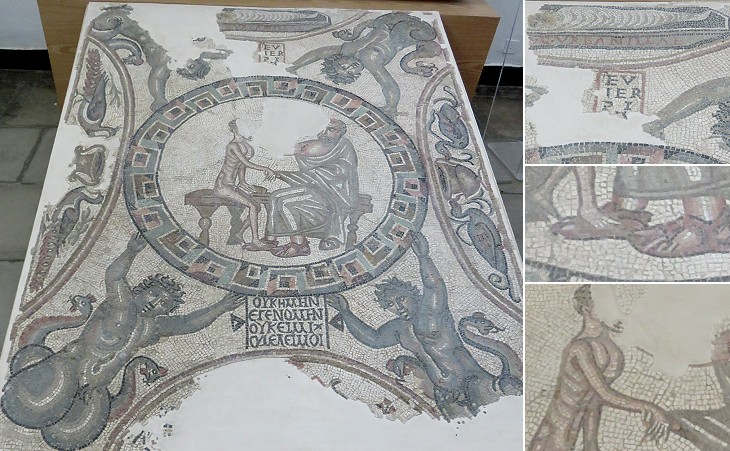
Archaeological Museum of Algiers: "The Physician" mosaic from near Lambaesis
This unusual mosaic decorated a tomb. It depicts a sarcophagus with the dead body of (Cornelia) Urbanilla aged 28 in its upper section. In the lower part a Greek inscription says: I did not exist, I existed, I exist no longer, I do not care. The central medallion portrays what apparently seems a medical examination. It has been interpreted as Asclepius, the god of Medicine, welcoming the soul of a "male" Urbanilla into the afterlife. In the Roman Empire a great number of religions or philosophical schools coexisted. Beliefs which originated in Egypt attributed to Hermes a role of psychopomp, i.e. of helper in the passage from death to afterlife (see a painting on a Greek vase). This task was eventually assigned to Asclepius, god of medicine, who was able to heal both souls and bodies. This philosophical approach or religion, today known as Hermeticism, affirmed that a single, true theology that is present in all religions was given by God to man in antiquity.
The presence of this mosaic in a faraway region shows the great extent to which ideas and individuals circulated in the Roman Empire.
Move to:
Introductory Page
Icosium (Algiers)
Tipasa
Lol or Caesarea Mauretaniae (Cherchell)
Cuicul (Djemila)
Thamugadi (Timgad)
Cirta or Constantina
Castellum Tidditanorum (Tiddis)
Hippo Regius (Annaba)
Archaeological Museum of Algiers

